
Oklahoma has just about every type of natural landscape contained in one state.
©Martha Marks/Shutterstock.com
From lush grasslands to multiple mountain ranges, Oklahoma has just about every type of natural landscape contained in one state. There is a lot of wildlife in Oklahoma, including a lot of snakes. Oklahoma is near the top of the list of states that have the most snakes. There are almost 50 native types of snakes in this state! And seven of those different types of snakes are venomous. So when you’re in Oklahoma it’s a smart idea to keep a sharp eye on the ground all around you no matter what you’re doing outdoors.
47 Snakes In Oklahoma

Oklahoma is near the top of the list of states that have the most snakes.
©Box Lab/Shutterstock.com
Even though it might seem like there’s an exceptionally large number of snakes in Oklahoma when you think about how many different types of habitats there are for snakes in Oklahoma it doesn’t seem surprising that there are so many. Just a few of the snakes that you can find in Oklahoma are:
Glossy Snake
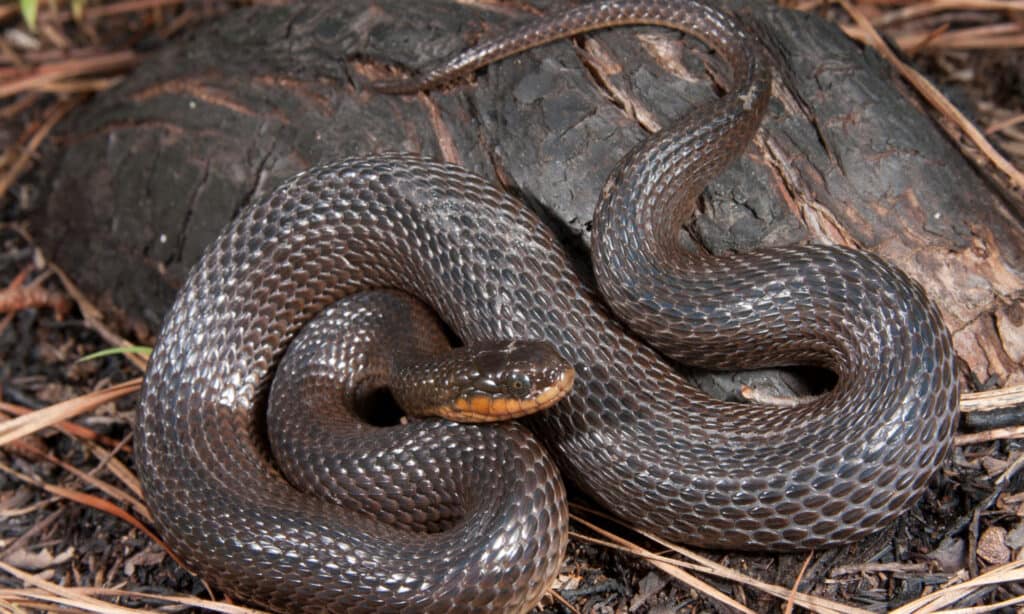
Glossy snakes are nocturnal, meaning you will likely only see them late at night or early in the morning before sunrise.
©Nathan A Shepard/Shutterstock.com
The Glossy snake is a nocturnal snake that likes to stay hidden so in Oklahoma, you probably won’t see this snake unless you are out and active late at night or early in the morning before it gets light. Glossy snakes have smooth scales with a reflective quality that makes them look like glass. They are usually gray or green with white bellies. The longest Glossy snakes can be up to four and a half feet long. But often they are more in the three to four-foot range.
Great Plains Rat Snake

A Great Plains Rat Snake look like they may be aggressive but they really aren’t.
©Patrick K. Campbell/Shutterstock.com
The Great Plains Rat snake can be shades of brown and tan with large irregular blotches for markings. This Rat snake never gets longer than three feet but can be as small as two feet long. Rat snakes are heavy and look like they might be aggressive but they really aren’t. They prefer to stay away from people. Great Plains Rat snakes typically are found in wooded areas or in grasslands. And they often take up residence in old buildings, barns, and sheds and eat the rodents they find in those buildings. If you are cleaning out an old building you might find a Great Plains Rat snake but it won’t bother you if you don’t bother it.
Coachwhip Snake
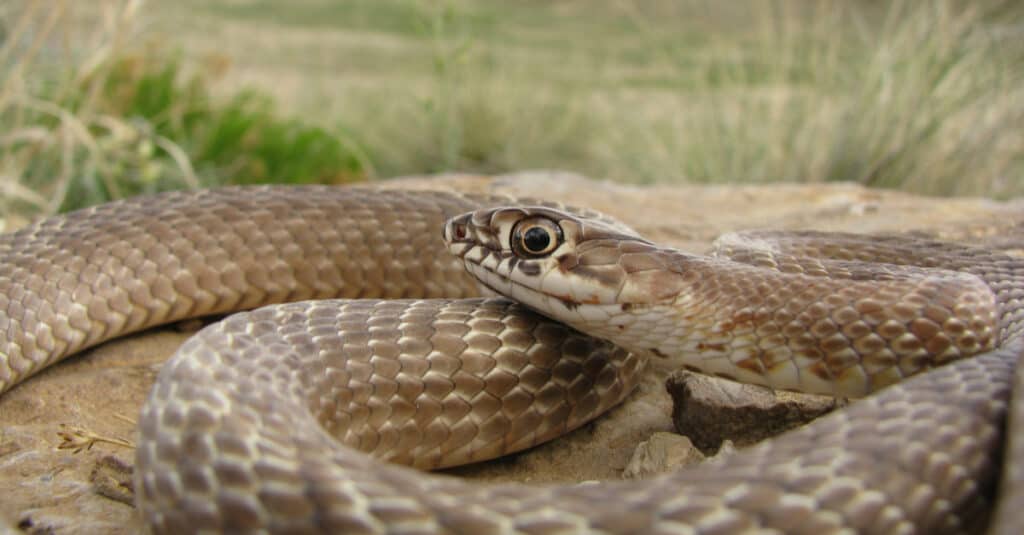
Coachwhip snakes will bite when cornered but are non-venomous.
©Joe Farah/Shutterstock.com
Coachwhip snakes are found to the east and west of I-81 cutting through Oklahoma and each type of Coachwhip has a different color pattern depending on where the snake is from. Eastern Coachwhip snakes have a body where the upper portion is black and it fades gradually to a red-brown color on the lower half. Western Coachwhip snakes are solid in color, usually black, and have a pinkish-red belly. Coachwhips can be up to a whopping six feet long and they move very quickly. It can also climb and may seek refuge in a tree if you surprise it. These snakes will bite if cornered or if they think they are being threatened but they are not venomous.
Prairie King Snake
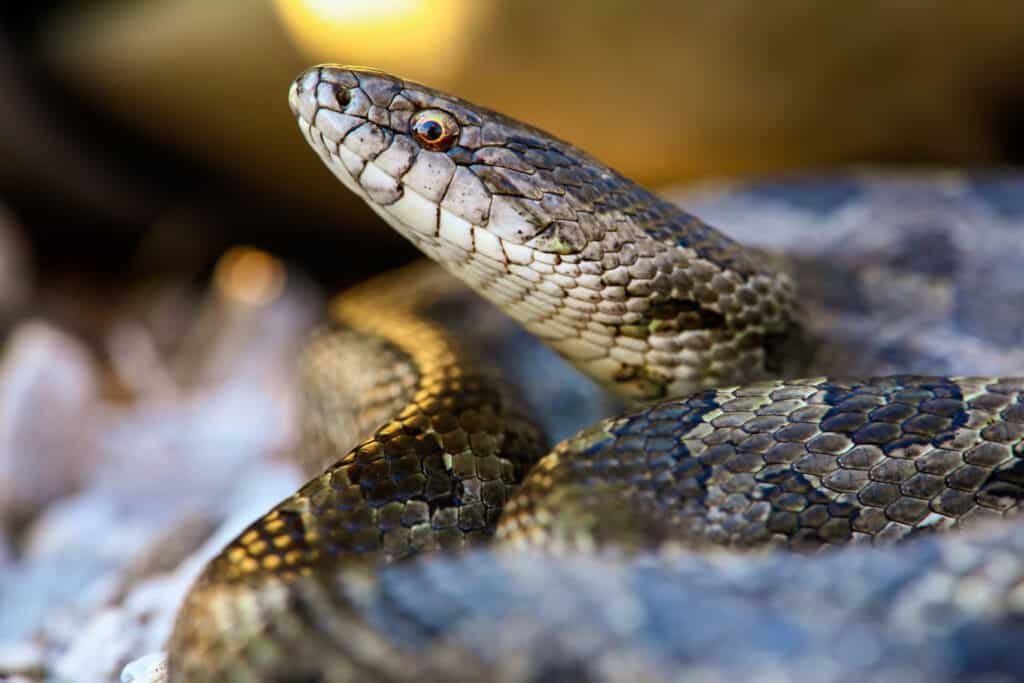
A Prairie King Snake is sociable and doesn’t mind being around humans.
©bradenjalexander/Shutterstock.com
The Prairie King snake is found throughout Oklahoma. These snakes are typically just three to four feet long but they have a heavy appearance. The body of the Prairie King snake is typically brown or tan with darker brown or black markings down the entire body. King snakes are sociable and don’t mind being around people. Because they aren’t scared of humans they often can be found hunting or nesting in old buildings, in fallen trees, and around homes and yards. Even though the Prairie King snake isn’t a threat to humans you should still be careful around them. Any snake can bite or be aggressive if it feels threatened.
Northern Water Snake
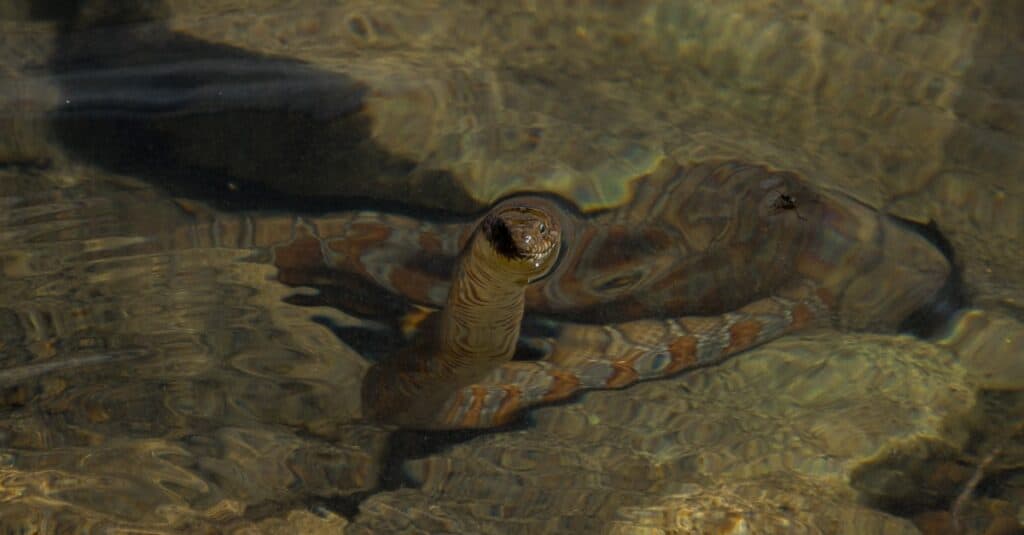
The Northern Water Snake can be confused for the venomous Cottonmouth.
©iStock.com/manuellacoste
Northern Water snakes are fully aquatic and can live in any type of water. Typically in Oklahoma, you will find them near lakes or ponds in the flat central regions but you can also find them in mountain streams and other bodies of water. These snakes are not long. Some are not even two feet long. But they have very heavy and wide bodies so they look bigger than they are. Water snakes have similar coloring to the Cottonmouth snake but they are not venomous like Cottonmouths. If you’re not sure if a snake is a Northern Water snake or a Cottonmouth look at the mouth. If the area near the mouth is white it’s probably a Cottonmouth but if there is no white then it’s a non-venomous Northern Water snake.
Venomous Snakes in Oklahoma
Oklahoma has a high number of venomous snakes compared to other states. It has one of the highest numbers of venomous snakes. Some of the venomous snakes in Oklahoma are:
Copperhead Snake
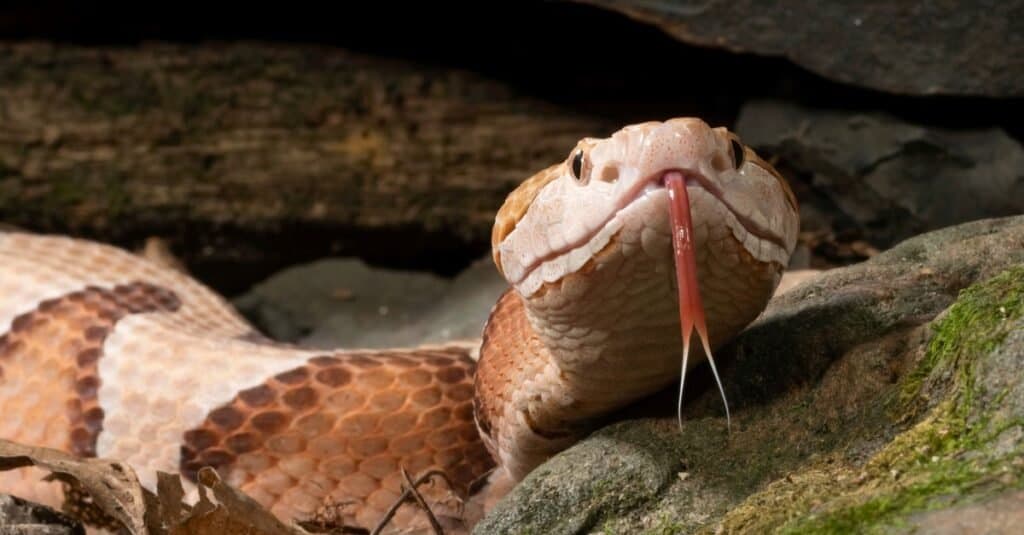
The Copperhead Snake is more likely to bite than other types of venomous snakes, so be careful when around them.
©Joe McDonald/Shutterstock.com
In Oklahoma, the Copperhead snake is mostly found in the eastern part of the state. There is a very solid population of Copperheads so always keep a sharp eye on the ground when you are raking leaves, cutting grass, or hiking in some of the state’s many state parks. Copperheads are only a couple of feet long but they are very wide. You can’t miss their distinctive copper color and unique markings but they will give a rattle to let you know they are there. These snakes are more likely to bite than other types of venomous snakes so always be very careful around Copperhead snakes.
Cottonmouth Snake

Cottonmouth Snakes are aquatic and venomous. Be on the lookout when boating and fishing in Oklahoma.
©Marcum Havens/Shutterstock.com
Cottonmouth snakes are aquatic and venomous. So if you’re the kind of person that spends time on the water boating or near the water fishing you should be watching for Cottonmouth snakes. Cottonmouths are usually dark olive to black and have solid-colored bodies. Their bellies are usually white or cream-colored. But the feature that you should look for to see if a snake is a Cottonmount is a patch of white around the outside of the snake’s mouth or on the inside. White mouth means Cottonmouth. And Cottonmouths are venomous so be wary of them.
Western Diamond Back Rattlesnake

Western Diamondback Snake
s are found in the western part of Oklahoma.
©Alexander Wong/Shutterstock.com
Western Diamond Back rattlesnakes are found in the western part of Oklahoma. These venomous snakes have alternating light and dark markings in a diamond pattern that makes this snake easy to identify. Like most rattlesnakes, the Western Diamondback will raise up and rattle before striking which should give you time to slowly back away if you come across one.
Western Massasauga Snake
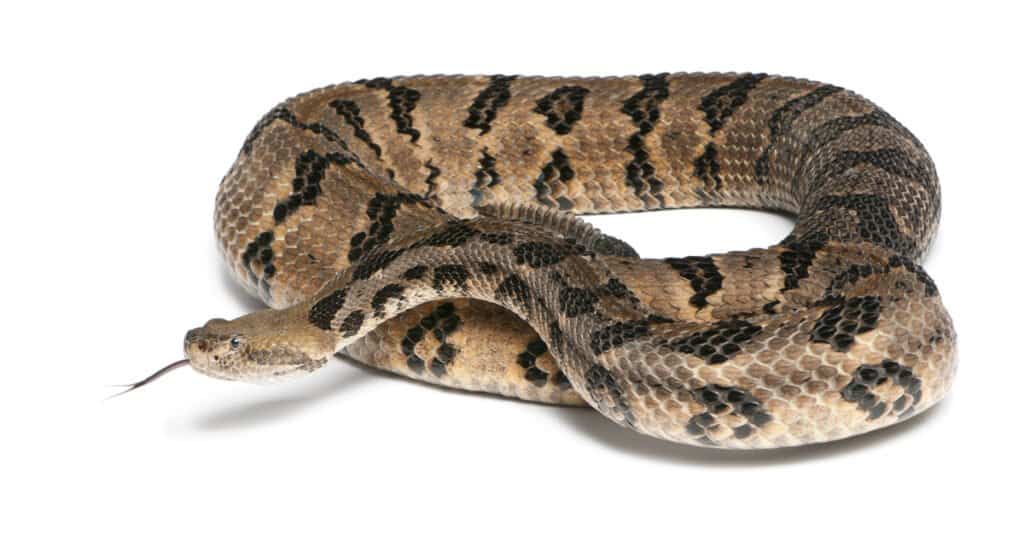
In Oklahoma, the Western Massasauga Snake is found in the western and northern parts of the state.
©fivespots/Shutterstock.com
Another small venomous snake is the Western Massasauga snake. In Oklahoma, this snake lives mainly in the western and northern parts of the state. Some Western Massasauga snakes are only about a foot and a half long. The longest ones are under three feet long. Western Massasauga snakes are light brown to tan with dark brown markings.
Pygmy Rattlesnake
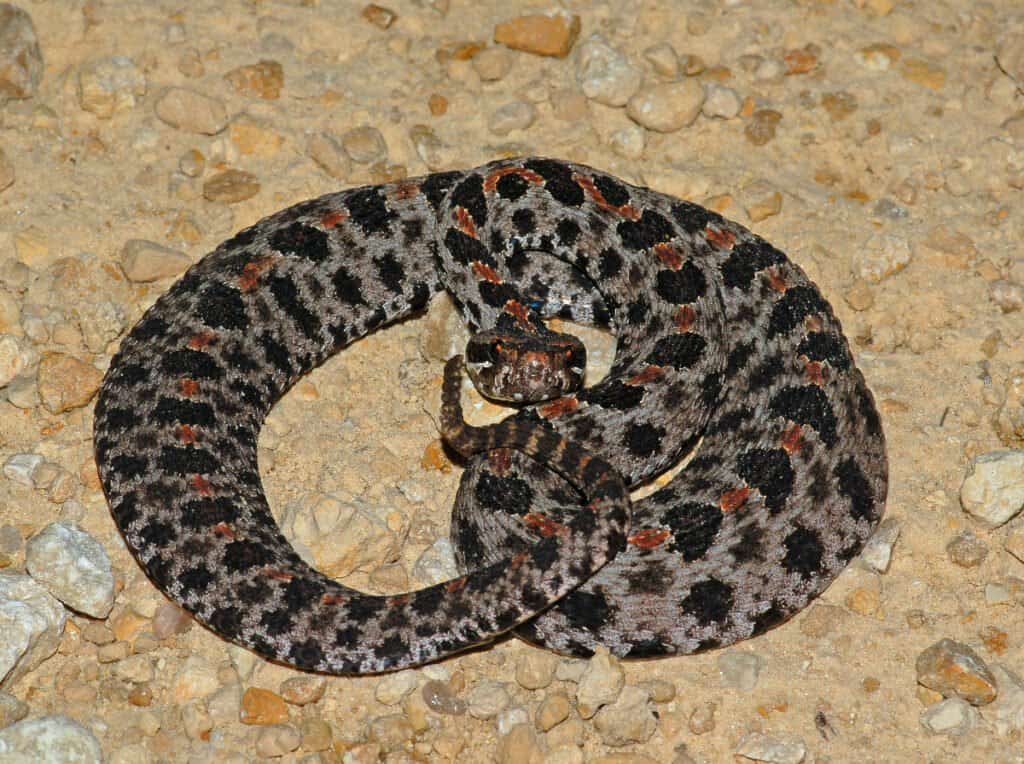
The Pygmy Rattlesnake is so small, you probably won’t see it until you are within its striking range.
©Gerald A. DeBoer/Shutterstock.com
Pygmy rattlesnakes are the smallest venomous snakes. They are typically just about a foot to a foot and a half long. The Pygmy rattlesnake’s small size actually makes it more dangerous than other larger rattlesnakes. Because the Pygmy is so small you probably won’t see it unless you’re in the snake’s striking range. If you startle a rattlesnake or if it feels cornered because you’re so close to it you may not get a warning rattle. The snake may just bite. Pygmy rattlesnakes are venomous and even though they are tiny their venom is potent.
A Complete List Of Snakes In Oklahoma
There is a good chance that you’re going to run into some snakes if you are outdoors at all in Oklahoma. Whether you live there or you are just visiting when you are fishing, hiking, working outdoors, or enjoying the beautiful country in Oklahoma there probably will be snakes around you. The complete list of snakes in Oklahoma that you might see are:
- Copperhead Snake
- Cottonmouth Snake
- Western Diamond Back Rattlesnake
- Timber Rattlesnake
- Prairie Rattlesnake
- Western Massasauga Snake
- Pygmy Rattlesnake
- Glossy Snake
- Worm Snake
- Scarlet Snake
- Southern Black Racer
- Ring-Neck Snake
- Great Plains Rat Snake
- Black Rat Snake
- Mud Snake
- Western Hognose Snake
- Eastern Hognose Snake
- Texas Night Snake
- Prairie King Snake
- Desert and Speckled King Snakes
- Milk Snake
- Blind Snake
- Glossy Water Snake
- Coachwhip Snake
- Yellow-Bellied Water Snake
- Broad-Banded Water Snake
- Diamond Back Water Snake
- Northern Water Snake
- Rough Green Snake
- Bull Snake
- Graham’s Water Snake
- Longnosed Snake
- Great Plains Ground Snake
- Brown Snake
- Texas Brown Snake
- Red-Bellied Snake
- Flat-Headed Snake
- Black-Headed Snake
- Black-Necked Garter Snake
- Wandering Garter Snake
- Checkered Garter Snake
- Western Ribbon Snake
- Plains Garter Snake
- Texas Garter Snake
- Lined Snake
- Rough Earth Snake
- Smooth Earth Snake
Other Reptiles In Oklahoma
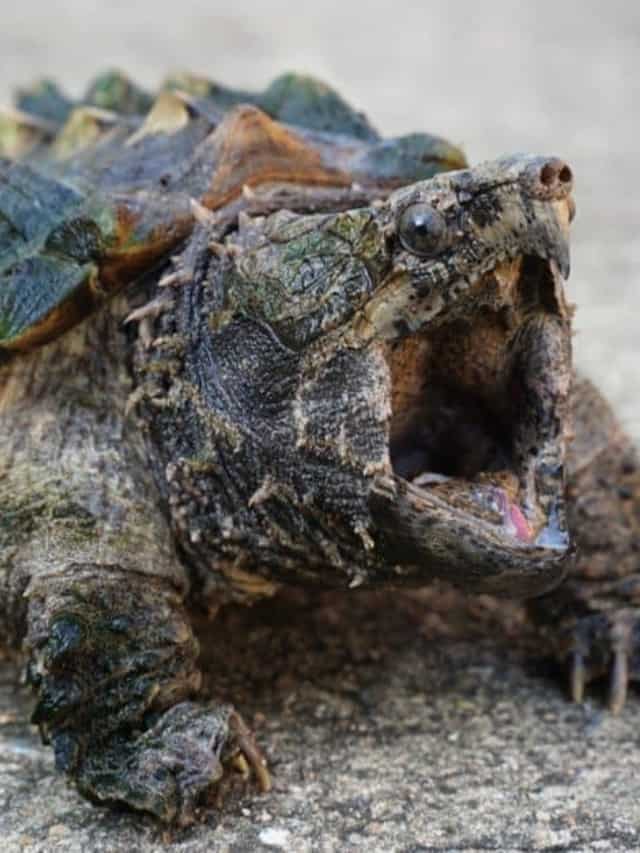
Alligator
Snapping Turtle
©Sista Vongjintanaruks/Shutterstock.com
The alligator snapping turtle is one of the more aggressive turtles and is not only the largest turtle found in Oklahoma but is the largest turtle found in North America. With weights that can reach 250 pounds and a shell length that can be over 2 feet in length, this reptile is very secretive, spending most of its life in the water. They are opportunistic feeders, scavenging for their meals, and eat a variety of food that includes birds, mussels, mammals, crayfish, and even other reptiles.
While they do not attack people, they are extremely aggressive reptiles, with a bite force of 1,000 pounds and powerful jaws that can snap through bone and should be left alone. This turtle’s numbers are in decline due to a decline in habit and being harvested for its meat but at the moment they are not considered, although protection has been proposed.
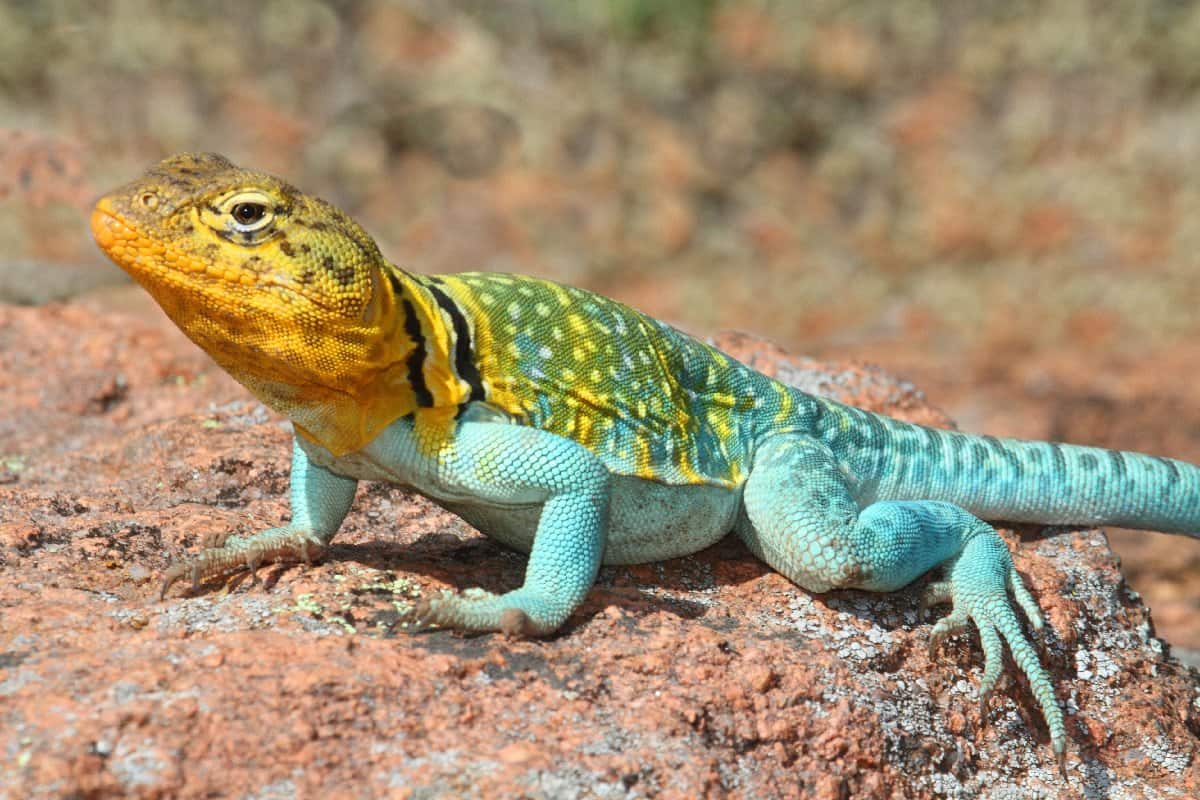
Eastern collared lizard, also called the common collared lizard, is a North American species.
©iStock.com/SteveByland
Endemic to North America is a colorful species of lizard that goes by many names – the Eastern collared lizard, common collared lizard, Oklahoma collared lizard. mountain boomer and yellow-headed collared lizard. This bright reptile is the Oklahoma State lizard and is relatively large, with males reaching about 4.5 inches and females reaching 4 inches. These lizards are not venomous but they do inflict a very painful bite that can break the skin. It is also not recommended that they be kept as pets as they do not do well in captivity and won’t survive.
Summary of the Multitude of Snakes in Oklahoma
If you find yourself walking around the bush in Oklahoma, here’s a handy summary of which of the snakes to look out for.
| Name | Venomous |
|---|---|
| Copperhead Snake | Yes |
| Cottonmouth Snake | Yes |
| Western Diamond Back Rattlesnake | Yes |
| Timber Rattlesnake | Yes |
| Prairie Rattlesnake | Yes |
| Western Massasauga Snake | Yes |
| Pygmy Rattlesnake | Yes |
| Glossy Snake | No |
| Worm Snake | No |
| Scarlet Snake | No |
| Southern Black Racer | No |
| Ring-Neck Snake | No |
| Great Plains Rat Snake | No |
| Black Rat Snake | No |
| Mud Snake | No |
| Western Hognose Snake | Yes |
| Eastern Hognose Snake | Yes |
| Texas Night Snake | Yes |
| Prairie King Snake | No |
| Desert and Speckled King Snakes | No |
| Milk Snake | No |
| Blind Snake | No |
| Glossy Water Snake | No |
| Coachwhip Snake | No |
| Yellow-Bellied Water Snake | No |
| Broad-Banded Water Snake | No |
| Diamondback Water Snake | No |
| Northern Water Snake | No |
| Rough Green Snake | No |
| Bull Snake | No |
| Graham’s Water Snake | No |
| Long-nosed Snake | No |
| Great Plains Ground Snake | No |
| Brown Snake | Yes |
| Texas Brown Snake | Yes |
| Red-Bellied Snake | No |
| Flat-Headed Snake | Yes |
| Black-Headed Snake | Yes |
| Black-Necked Garter Snake | No |
| Wandering Garter Snake | No |
| Checkered Garter Snake | Yes |
| Western Ribbon Snake | No |
| Plains Garter Snake | No |
| Texas Garter Snake | No |
| Lined Snake | No |
| Rough Earth Snake | No |
| Smooth Earth Snake | No |
Which U.S. State Has the Most Snake Bites?
As we’ve discovered, there’s a whole lotta snake species slithering around in Oklahoma. In fact, Oklahoma ranks 4th in the nation for snake bites per year, specifically, 61 million snake bites per million population.
But which state ranks the highest in snake bites? That would be North Carolina. The snake bite rate in this southeastern state is 157.8 bites per million population annually. As the population as of 2021 was a little over 10 million (10.55 to be exact), and we were to just figure it off of 10 million, that would average out to roughly 1,580 reported snake bites per year.
The top 6 states for reported snake bites are:
| Rank | State | Bites per Million |
|---|---|---|
| 1 | North Carolina | 157.8 |
| 2 | West Virginia | 105.3 |
| 3 | Arkansas | 92.9 |
| 4 | Oklahoma | 61 |
| 5 | Virginia | 48.7 |
| 6 | Texas | 44.2 |
There are 6 different kinds of venomous snakes inhabiting North Carolina: copperhead, cottonmouth, eastern coral snake, eastern diamondback rattlesnake, pigmy rattlesnake, and timber rattlesnake. In the year 2019, there were 92 people bitten by venomous snakes in that state.
The photo featured at the top of this post is © Marcum Havens/Shutterstock.com
Discover the "Monster" Snake 5X Bigger than an Anaconda
Every day A-Z Animals sends out some of the most incredible facts in the world from our free newsletter. Want to discover the 10 most beautiful snakes in the world, a "snake island" where you're never more than 3 feet from danger, or a "monster" snake 5X larger than an anaconda? Then sign up right now and you'll start receiving our daily newsletter absolutely free.
FAQs (Frequently Asked Questions)
What are some snakes to look out for in Oklahoma?
Oklahoma has a high number of venomous snakes compared to other states. Some of the snakes to look out for is the Pygmy Rattlesnake, Cottonmouth Snake, Western Diamondback Rattlesnake, and Copperhead Snake.
Why does Oklahoma have so many varieties of snakes?
From lush grasslands to multiple mountain ranges Oklahoma has just about every type of natural landscape contained in one state. There is a lot of wildlife in Oklahoma, including a lot of snakes.
Thank you for reading! Have some feedback for us? Contact the AZ Animals editorial team.






